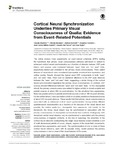Cortical neural synchronization underlies primary visual consciousness of qualia: evidence from event-related potentials

Ver/Abrir
Use este enlace para citar
http://hdl.handle.net/2183/17204
Excepto si se señala otra cosa, la licencia del ítem se describe como Creative Commons Attribution 4.0 International License (CC-BY 4.0)
Colecciones
- Investigación (FCS) [1293]
Metadatos
Mostrar el registro completo del ítemTítulo
Cortical neural synchronization underlies primary visual consciousness of qualia: evidence from event-related potentialsAutor(es)
Fecha
2016-06-30Cita bibliográfica
Babiloni C, Marzano N, Soricelli A, Cordone S, Millán-Calenti JC, Del Percio C and Buján A. Cortical neural synchronization underlies primary visual consciousness of qualia: evidence from event-related potentials. Front Hum Neurosci. 2016;10(310)
Resumen
[Abstract] This article reviews three experiments on event-related potentials (ERPs) testing the hypothesis that primary visual consciousness (stimulus self-report) is related to enhanced cortical neural synchronization as a function of stimulus features. ERP peak latency and sources were compared between “seen” trials and “not seen” trials, respectively related and unrelated to the primary visual consciousness. Three salient features of visual stimuli were considered (visuospatial, emotional face expression, and written words). Results showed the typical visual ERP components in both “seen” and “not seen” trials. There was no statistical difference in the ERP peak latencies between the “seen” and “not seen” trials, suggesting a similar timing of the cortical neural synchronization regardless the primary visual consciousness. In contrast, ERP sources showed differences between “seen” and “not seen” trials. For the visuospatial stimuli, the primary consciousness was related to higher activity in dorsal occipital and parietal sources at about 400 ms post-stimulus. For the emotional face expressions, there was greater activity in parietal and frontal sources at about 180 ms post-stimulus. For the written letters, there was higher activity in occipital, parietal and temporal sources at about 230 ms post-stimulus. These results hint that primary visual consciousness is associated with an enhanced cortical neural synchronization having entirely different spatiotemporal characteristics as a function of the features of the visual stimuli and possibly, the relative qualia (i.e., visuospatial, face expression, and words). In this framework, the dorsal visual stream may be synchronized in association with the primary consciousness of visuospatial and emotional face contents. Analogously, both dorsal and ventral visual streams may be synchronized in association with the primary consciousness of linguistic contents. In this line of reasoning, the ensemble of the cortical neural networks underpinning the single visual features would constitute a sort of multi-dimensional palette of colors, shapes, regions of the visual field, movements, emotional face expressions, and words. The synchronization of one or more of these cortical neural networks, each with its peculiar timing, would produce the primary consciousness of one or more of the visual features of the scene.
Palabras clave
Primary visual consciousness
Qualia
High-resolution electroencephalography (EEG)
Event-related potentials (ERPs)
Cortical neural synchronization
Dorsal visual stream
Ventral visual stream
Qualia
High-resolution electroencephalography (EEG)
Event-related potentials (ERPs)
Cortical neural synchronization
Dorsal visual stream
Ventral visual stream
Versión del editor
Derechos
Creative Commons Attribution 4.0 International License (CC-BY 4.0)






